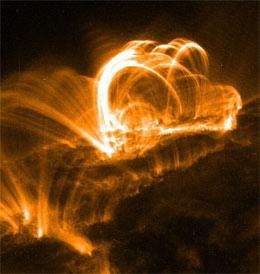Christoffer Karoff and Hans Kjeldsen of the University of Aarhus say that these outbursts in the Sun's outer layers drive oscillations throughout the Sun "in the same way that the entire Earth is set ringing for several weeks after a major earthquake."
This possibility was first proposed in the 1970s, but has not been demonstrated until now. "It's the first observational evidence of this that I'm aware of," says Günter Houdek, a solar physicist at the University of Cambridge in England who was not involved with the work.

|
| ©Unknown |
| The quakes caused by flares should be visible on other stars. |
The Danish researchers think that not only could their finding help us understand the physics of the Sun, but it might also provide a way of probing cycles of activity in other stars. They will present their work in a forthcoming paper in Astrophysical Journal Letters.
Solar seismology
Monitoring oscillations in the Sun - a discipline called helioseismology - is now a well established technique for studying the Sun's physical structure, such as its division into distinct layers of hot gas and plasma.
In general, these oscillations are though to be caused by turbulent convection near the solar surface, as hot material rises from deeper down and sinks again as it cools. This motion sets up a kind of noisy background shaking over a wide range of frequencies.
That has tended to obscure any oscillations caused by local, specific events such as solar flares - vast eruptions of hot plasma created by sudden changes in the Sun's magnetic field. These release immense amounts of energy, and are known to excite ripples like those on the surface of a pond when a pebble falls in.
Solar flares are particularly common around sunspots, and show a cycle of activity that mirrors the sunspot cycle, peaking every 11 years or so. When Karoff and Kjeldsen studied data from two Sun-watching satellites (the Solar and Heliospheric Observatory and the Geostationary Operational Environmental Satellite), they found that whole-star high-frequency oscillations are more prominent when solar flares are more active, implying a connection between them. The oscillations are observed indirectly: shifts in the frequency of light being emitted by the Sun, caused by movements of the solar surface, can be picked up by these satellites and translated into the shakes that caused them.
"This is just a first observation," says Karoff. "Now the real work starts. We need to figure out how the energy from the flares is delivered into the oscillations."
Throwing light on the Sun
Working this out will entail devising a detailed model of the Sun's structure in the region where flares and sunspots form.
Houdek thinks that such follow-up work could shed light on the solar cycle, which is not fully understood. "We still don't know where the 'seat' of the solar cycle is," he says. It might also reveal a feedback loop between sunquakes and flares: while the oscillations the team spotted are thought to be a response to flare activity, Houdek thinks the vibrations might also alter the Sun's structure and thus affect the flare-forming process.
Karoff is also excited by what this finding might do for our understanding of other stars. It has been very difficult to study whether other stars have a cycle of flares and spots comparable to that of our Sun, simply because they are too far away to see. But now, by unpicking the signal of oscillations from starlight, one might be able to infer cycles of flare activity on distant stars.
"If we can see the same kind of signal in other stars, it will suggest that they have flares too," says Karoff. Such data might be provided by astronomical satellites such as NASA's Kepler telescope, scheduled for launch early next year.



Reader Comments
to our Newsletter